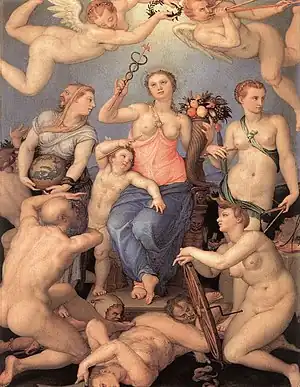
Allegory of Happiness is an oil on copper painting by Bronzino, probably first produced for the Studiolo of Francesco I, signed BROZ. FAC. and now in the Uffizi in Florence.[1][2][3][4] It is now in a fluted and gilded 17th century wooden frame.[5] Most art historians date it to around 1567, and it is first mentioned in the Uffizi inventory in 1635/8.[6][7]
Iconography
Happiness is represented as a young woman in the centre of the painting with Cupid as a girl, representing love.[8] Prudence and Justice stand on either side of her, whilst the conquered enemies of peace and Fortune, with her wheel, lie at her feet.[9][10] Graham Smith argues that this ideal state of happiness is Florence, and that it celebrates Cosimo I for the great public well-being of the time.[11]
References
- ↑ Numero inventario: 1543.
- ↑ "Uffizi catalogue entry" (in Italian).
- ↑ Luciano Berti, Il Principe dello Studiolo, Firenze, Maschietto Editore, 2002.
- ↑ Gallerie degli Uffizi, Gli Uffizi: Catalogo generale, Firenze, Centro Di, 1980, p. 190 [1979], SBN IT\ICCU\RAV\0060995.
- ↑ Edi Baccheschi (ed), L'opera completa del Bronzino introdotta da scritti del pittore, Milano, Rizzoli, 1999, n. 125, SBN IT\ICCU\UBO\1475918.
- ↑ Andrea Emiliani, Il Bronzino; con un'antologia poetica scelta e presentata da Giorgio Cerboni Baiardi, Busto Arsizio, Bramante, 1960, SBN IT\ICCU\SBL\0517132, tav. 96
- ↑ "Allegoria della Felicità :: Agnolo Bronzino ► 1503-1572". Virtual Uffizi Gallery. Retrieved 2021-02-05.
- ↑ "Allegory of Happiness by BRONZINO, Agnolo". www.wga.hu. Retrieved 2021-02-05.
- ↑ "Allegory of Happiness by BRONZINO, Agnolo". www.wga.hu. Retrieved 2021-02-05.
- ↑ Smith, Graham (1984). "Bronzino's Allegory of Happiness". The Art Bulletin. 66 (3): 390–399. doi:10.2307/3050442. ISSN 0004-3079. JSTOR 3050442.
- ↑ Smith, Graham (1984). "Bronzino's Allegory of Happiness". The Art Bulletin. 66 (3): 390–399. doi:10.2307/3050442. ISSN 0004-3079. JSTOR 3050442.
.jpg.webp)